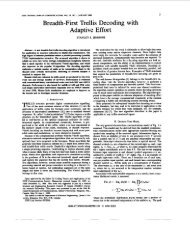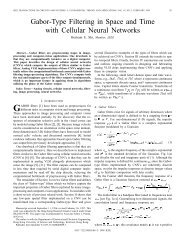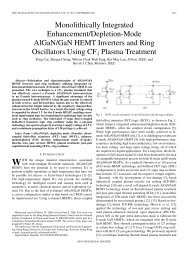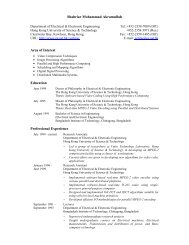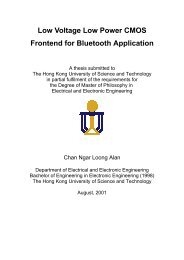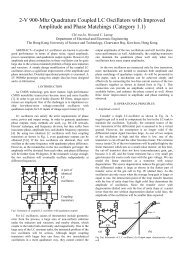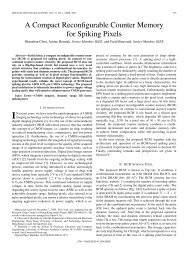Thesis - Department of Electronic & Computer Engineering
Thesis - Department of Electronic & Computer Engineering
Thesis - Department of Electronic & Computer Engineering
Create successful ePaper yourself
Turn your PDF publications into a flip-book with our unique Google optimized e-Paper software.
The degradation due to collisions in response time can be explained by the gainloss analysis. The loss <strong>of</strong> the pulses can be regarded as the loss in the recurrentstrength, ab , .When the neurons fire frequently enough, the pulse coupled network can be treatedas a continuous network with less recurrent strengths to compensate for the loss due tocollisions. In this way, we will have different equivalentrate.ab ,for different collisionThe equivalent recurrent strengths area∗ = b∗ = 0.5 ⋅ ( 1 – p l),p lwhere denotes the average collision rate.To work at the WTA regime, the equivalent recurrent strengths must satisfyb∗ > ( 1 – a∗) ( 1 – δ), which can be reduced to1 – δa∗ > 2 ----------- – δ0.9= ------ = 0.47371.9We study how the response time changes with the normalized average equivalentrecurrent strengtha∗-----awhen the firing rate is high, and compare the simulation resultswith those <strong>of</strong> the continuous model (Related data is listed in Table. 2 in appendix). Asshown in Fig. 5.11, the non-arbitered pulse coupled model exhibits the same qualitativecharacteristics as the continuous model does, although they are not matched well,they have the same trend. It is necessary to note that the equivalent recurrent strengthsare varying with time in the non-arbitered pulse coupled model, while the strengths inthe continuous model are kept constant. This may account for some <strong>of</strong> the mismatches.54



